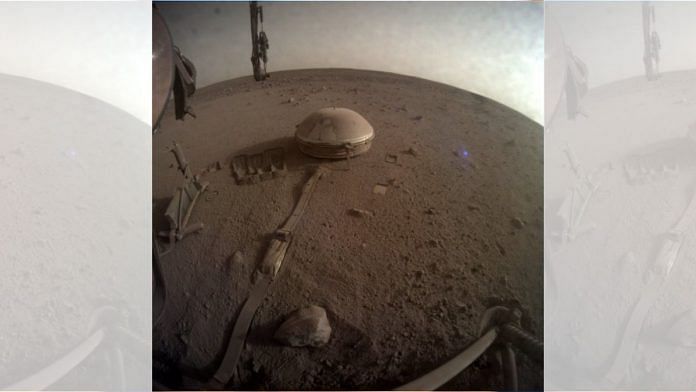Bengaluru: Mars is the only planet to be populated by roving, stationary, and orbiting robots, and it is also the first one in the process of turning into a robot graveyard.
After ISRO’s Mangalyaan mission was declared over earlier this year, it is now the turn of USA’s Interior Exploration using Seismic Investigations, Geodesy and Heat Transport (InSight) mission, which made the red planet its home in 2018, to do the same. It had been active for 1445 sols (Martian days) or 1485 Earth days.
In probably its last message, the team behind InSight tweeted a wide-angle photo from the robot Tuesday, with the text, “My power’s really low, so this may be the last image I can send”.
My power’s really low, so this may be the last image I can send. Don’t worry about me though: my time here has been both productive and serene. If I can keep talking to my mission team, I will – but I’ll be signing off here soon. Thanks for staying with me. pic.twitter.com/wkYKww15kQ
— NASA InSight (@NASAInSight) December 19, 2022
The stationary lander, which is located at Elysium Planitia, a plain at the Martian equator, was put in low-power mode since July, as its solar panels started to gather dust.
InSight used seismometers to understand seismic activity and Mars quakes, and discern the interior of the planet enough to create 3D models of it. Its objectives also included measuring heat transfer on the surface and thus understanding Martian geological evolution.
Also read: 5-minute flight, 2 Indian & 1 foreign payloads — India launches first private rocket
Science findings
Since it landed on Mars, InSight has detected over a thousand seismic events, with at least 50 of them providing signs clear enough to derive new information. The most recent quake was detected in May this year, at an estimated magnitude of 5 on the Richter scale, and with vibration reverberating through the planet for six hours.
Many quakes recorded by InSight turned out to be meteoroid strikes and the magnetometer carried by the robot could determine the remaining traces of a global magnetic field inside of rocks several metres underground.
The robot helped provide new information about the interior of Mars. Scientists could confirm that the crust was thinner than previously believed (25-40 km thick), and made up of three layers. Seismic waves traveling through the upper mantle reached a depth of about 800km before bouncing back to the surface.
InSight discovered through studying heat transfer that the Martian core is much bigger than expected, at 1,800km radius.
The lander also collected exhaustive weather data, more comprehensive than any mission before it. It sensed winds, observed dust storms and dust devils, and recorded turbulence as well as infrasound.
Other missions
There are currently multiple landers, rovers, orbiters, and a helicopter on Mars.
NASA’s Mars Odyssey orbiter and European Space Agency’s (ESA) Mars Express have been sending back data for over a decade now. NASA’s Mars Reconnaissance Orbiter too has been instrumental in imaging all of the Martian surface and sending back images of landings and impacts on the planet.
NASA’s MAVEN orbiter is still operational, as is ESA/Roscosmos’s ExoMars Trace Gas Orbiter. ISRO’s Mangalyaan or Mars Orbiter Mission (MOM) lost contact with Earth in April 2022.
UAE’s Hope orbiter and China’s Tianwen-1 orbiter are also operational.
The Curiosity and Perseverance rovers sent by NASA are still moving around on the red planet, studying it in great detail, as is China’s Zhurong rover.
NASA’s Ingenuity is the only helicopter on Mars, and is the first helicopter capable of powered flight to be sent to any other planet.
(Edited by Poulomi Banerjee)
Also read: Why did methane levels shoot up in Covid yr? Warm weather, and less pollution






